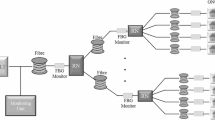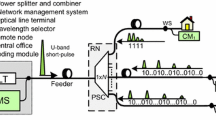Abstract
The need to implement techniques to monitor optical fiber links in passive optical networks (PONs), based on the principle of reflectometry, has motivated various research projects. Such studies are especially important for networks with tree topology or hierarchical topology, due to the difficulty to determine in which specific fiber branch there was rupture. This work proposes a novel model based on fiber Bragg grating to solve the complexity in the monitoring of point-multipoint networks. This mode uses multiple access techniques by division of optical codes in phase, to monitor the PONs. The work involved developing a novel PON monitoring model to detect fiber optic branches with problems that are analyzed by means of autocorrelation of optical pulses reflected by Bragg gratings. These Bragg gratings are strategically arranged in network terminal units. The results obtained through simulations demonstrate the viability of the proposed approach applied in Bragg grating 63 chips for identifies fault, in real time, in the network with 8, 16, 32 or 63 users. The system satisfactorily demonstrated its ability to monitor PONs, using fewer Bragg gratins and couplers, compared to the other models found in the literature, such as fault location in passive optical networks using T-Optical time-domain reflectometer and wavelength-selective isolators, remote coding scheme based on waveguide Bragg grating in power line communication splitter chip for PONs monitoring, optimal fiber link fault decision for optical 2D coding-monitoring scheme in passive optical networks, and centralized PONs monitoring scheme based on optical coding.










Similar content being viewed by others
References
Xiong, Y., Sun, P., & Li, Z. (2017). Novel ring-based architecture for TWDM-PON with high reliability and flexible extensibility. Optics Communications, 384, 41–49.
Bindhaiq, S., Supa’at, A., Zulkifli, N., Mohammad, A., Shaddad, R., Elmagzoub, M., et al. (2015). Recent development on time and wavelength-division multiplexed passive optical network (TWDM-PON) for next-generation passive optical network stage 2 4(NG-PON2). Journal of Switching and Networking, 15, 53–66.
Butt, R. A., Idrus, S. M., Qureshi, K. N., Zulkifli, N., & Mohammad, S. H. (2017). Improved dynamic bandwidth allocation algorithm for XGPON. Journal of Optical Communications and Networking, 9(1), 87–97.
Matsumoto, R., Kodama, T., Shimizu, S., Nomura, R., Omichi, K., Wada, N., et al. (2014). 40G-OCDMA-PON system with an asymmetric structure using a single multi-port and sampled SSFBG encoder/decoders. Journal of Lightwave Technology, 32(6), 1132–1143.
Hsing, C. Y., Chia, C. W., Che, L. Y., Li, C. W., Cheng, L. I., & Chen, J. (2017). Frequency- and time-domain nonlinear distortion compensation in high-speed OFDM-IMDD LR-PON with high loss budget. Optics Express, 25(5), 5044–5056.
Lannoo, B., Das, G., Dixit, A., Colle, D., Figkavet, M., & Demeester, P. (2013). Novel hybrid WDM/TDM PON architectures to manage flexibility in optical access networks. Telecommunication Systems, 54(2), 147–165.
Houtsma, V., & Van Veen, D. (2017). A study of options for high-speed TDM-PON beyond 10G. Journal of Lightwave Technology, 35(4), 1059–1066.
van Veen, D., & Houstsma, V. (2016). High Speed TDM-PON Beyond 10G. In Proceedings of OFC 2016, paper Tu3C.3, Anaheim, USA.
Li, C., Guo, W., Wang, W., Hu, W., & Xia, M. (2016). Bandwidth resource sharing on the XG-PON transmission convergence layer in a multi-operator scenario. Journal of Optical Communications and Networking, 8(11), 835–843.
Zhu, M., Zhang, J., Wang, D., & Sun, X. (2016). Optimal fiber link fault decision for optical 2D coding-monitoring scheme in passive optical networks. Journal of Optical Communications and Networking, 8(3), 137–147.
Urban, P.J., Vall-llosera, G., Medeiros, E., & Dahlfort, S. (2013). Fiber plant manager: an OTDR-and OTM- based PON monitoring system, IEEE Communications Magazine, pp. S9–S15.
Yuskel, K., Moeyaert, V., Wuilart, M., & Mégret, P. (2008). Optical layer monitoring in passive optical networks (PONs): A review, Transparent Optical Networks, pp. 92–98.
Nakao, N., Izumita, H., Inoue, T., Enomoto, Y., Araki, N., & Tomita, N. (2001). Maintenance method using 1650-nm wavelength band for optical fiber cable networks. Journal of Lightwave Technology, 19(10), 1513–1520.
Enbutsu, K., Araki, N., Honda, N., & Azuma, Y. (2009). Individual fiber line testing technique for PONs using TLS-OTDR enhanced with reflected backward light analysis method, Optical Fiber Communication.
Temporão, G. P., Vilela de Faria, G., Urban, P. J., & Pierre Von Der Weid, J. (2013). Fault location in passive optical networks using T-OTDR and wavelength-selective isolators. In Optical fiber communication conference and exposition and the national fiber optic engineers conference (OFC/NFOEC).
Yuksel, K., Dupont, S., Hamoir, D., & Froidure, J.-C. (2005). FTTx automated test solution: Requirements and experimental implementation. Eletronics Letters, 41(9), 546–547.
Marhic, M. E. (1993). Coherent optical CDMA networks. Journal of Lightwave Technology, 11(5–6), 854–864.
Esmail, M. A., & Fathallah, H. (2013). Physical layer monitoring techniques for TDM-passive optical networks: A survey. IEEE Communications Surveys and Tutorials, 15(2), 943–958.
Hadi, M., & Pakravan, M. R. (2017). Analysis and design of adaptive OCDMA passive optical networks. Journal of Lightwave Technology, 35(14), 2853–2863.
Zhang, X., Lu, F., Chen, S., Zhao, X., Zhu, M., & Sun, X. (2016). Remote coding scheme based on waveguide Bragg grating in PLC splitter chip for PON monitoring. Optics Express, 24(5), 4351–4364.
Geiger, H., Fu, A., Petropoulos, P., Ibsen, M., Richardson, D. J., Laming, R. I. (1998). Demonstration of a simple CDMA transmitter and receiver using sampled fibre gratings, ECOC98, pp. 337–338.
Hill, K. O., & Meltz, G. (1997). Fiber Bragg grating technology fundamentals and overview. Journal of Lightwave Technology, 15(8), 1263–1276.
Zhou, X., Zhang, F., & Sun, X. (2013). Centralized PON monitoring scheme based on optical coding. IEEE Photonics Tecnhology Letters, 25(9), 795–797.
Dinan, E. H., & Jabbari, B. (1998). Spreading codes for direct sequence CDMA and wideband CDMA cellular networks. IEEE Communications Magazine, 36, 48–54.
Chan, C. F., Chen, C., Jafari, A., Laronche, A., Thomson, D. J., & Albert, J. (2007). Optical fiber refractometer using narrowband cladding-mode resonance shifts. Applied Optics, 46(7), 1142–1149.
Agrawal, G. P. (2009). Applications of nonlinear fiber optics (2nd ed.). Boston: Academic Press.
Guimarães, G. F. (2010). Análise de Desempenho de Sistema Modulado PPM/PAM Operando com Codificação OCDMA e códigos Gold sob Efeitos Ópticos Não-Lineares. Master’s thsis (Engenharia de Teleinformática, Departamento de Engenharia de Teleinformática, Universidade Federal do Ceará), Fortaleza.
Acknowledgements
We formally thank the National Council for Scientific and Technological Development (CNPq), the Ceará State Agency for Technology and Scientific Development (FUNCAP) and the Coordination for the Improvement of Higher Level Personnel (CAPES) for the financial support provided for the accomplishment of this work. VHCA acknowledges the sponsorship from the Brazilian National Council for Research and Development (CNPq) via Grant No. 301928/2014-2. JJPCRodrigues acknowledges the National Funding from the FCT—Fundação para a Ciência e a Tecnologia through the UID/EEA/50008/2013 Project, by the Government of the Russian Federation, Grant 074-U01, by Brazilian National Council for Research and Development (CNPq) via Grant No. 309335/2017-5, and by Finep, with resources from Funttel, Grant No. 01.14.0231.00, under the Centro de Referência em Radiocomunicações—CRR project of the Instituto Nacional de Telecomunicações (Inatel), Brazil.
Author information
Authors and Affiliations
Corresponding author
Ethics declarations
Conflicts of interest
On behalf of all authors, the corresponding author states that there is no conflict of interest.
Rights and permissions
About this article
Cite this article
Fragoso, K.A., da Conceição Ferreira, A., Bandeira, D.G.C. et al. A novel remote optical coding for PON monitoring systems using fiber bragg grating. Telecommun Syst 69, 27–37 (2018). https://doi.org/10.1007/s11235-018-0423-7
Published:
Issue Date:
DOI: https://doi.org/10.1007/s11235-018-0423-7




